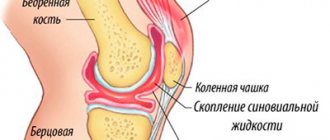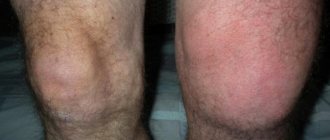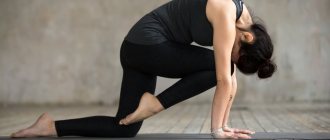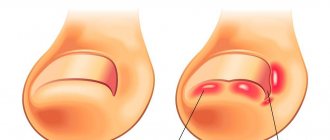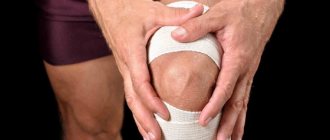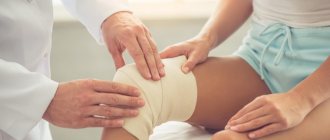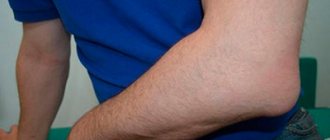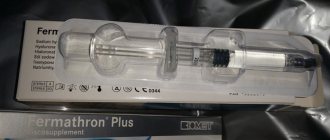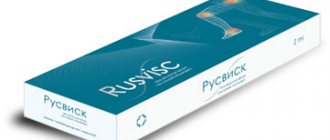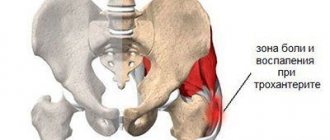- How painful is pumping?
After injuries and some diseases, fluid accumulates in the knee joint. The large volume compresses soft tissues and blood vessels, disrupting the nutrition of the joint and causing pain in the knee. In order to find out the cause of the pathology and alleviate the patient’s condition, fluid is pumped out from the knee joint. At the Paramita Medical Center in Moscow, this is done by professionals with extensive clinical experience.
Indications and contraindications
The knee is most susceptible to injury because it endures heavy physical activity and is not sufficiently protected by soft tissue. Very often, after a knee injury, fluid accumulates in the joint cavity.
No less often, the causes of inflammation of the synovial membrane and the appearance of fluid are degenerative-dystrophic (osteoarthrosis of the knee joint - gonarthrosis) and infectious (arthritis, synovitis of bacterial origin) diseases of the joints. Finally, fluid accumulation in the knee occurs against the background of metabolic disorders such as gout and some common diseases.
Under the influence of all these reasons, the synovial membrane lining the inner surface of the joint cavity becomes inflamed. This leads to the active release of synovial fluid, which compresses the surrounding tissues, supporting the development of the inflammatory process, pain and movement disorders.
In order to find out the cause and nature of the pathological process, alleviate the patient’s condition and speed up recovery, a diagnostic and treatment procedure is performed - pumping out fluid from the knee joint.
Indications for surgical intervention - pumping out exudate - are severe pain and impaired movement in the knee. Removal of fluid from the knee joint should be carried out when:
- inflammation of the joint capsule (synovitis);
- gonarthrosis;
- injury – inflammation develops in the injured knee;
- rheumatoid arthritis;
- any general diseases that contribute to the accumulation of exudate.
Is it necessary to pump out fluid from the knee joint every time it is detected? Not at all, if the amount of fluid is increased slightly, pain and movement disorders are moderate, then treatment should begin with conservative methods.
Removal of knee effusion is contraindicated if:
- decompensated diabetes mellitus;
- severe cardiovascular diseases;
- blood clotting disorders;
- purulent inflammatory processes of the skin;
- adhesions in the articular cavity;
- the presence of an allergic reaction to anesthetics.
What will happen if you don’t pump out the exudate and let everything take its course?
If fluid has accumulated in the knee joint for a long time, there are indications for its removal, then surgery must be performed, otherwise complications will begin:
- an aseptic (sterile) inflammatory process
can turn into an infectious, purulent one, which will significantly worsen the patient’s condition and the prognosis of the disease; this is accompanied by an increase in temperature and a deterioration in general condition; - purulent inflammation
leads to the destruction of cartilage and bone tissue; the pus must be removed and the cavity rinsed with an antiseptic; - after inflammation becomes chronic,
adhesions form in the articular cavity, and persistent immobility (contracture) of the knee develops.
Reasons for education
The knee joint is a hinge that works for flexion and extension, as well as movement around an axis. It includes a large number of elements:
- ligaments;
- muscles;
- tibia;
- femur;
- patella.
In order to withstand constant loads, the entire system must act harmoniously, and if the functioning of one of the elements is disrupted, a malfunction occurs, reducing the mobility of the joint and often accompanied by severe pain. Effusion in the joint cavity can form as a result of mechanical damage, autoimmune disease, or metabolic disorders in the body.
The most common is the first group, which manifests itself in the form of bone fractures, damage to the meniscus, rupture or sprain of ligaments, and disruption of the integrity of the joint capsule. Such injuries are often found in professional athletes and dancers who endure heavy physical exertion. Moreover, if an open wound is formed, bacteria can enter the intra-articular fluid, which will lead to the development of an infectious lesion and purulent inflammation: bursitis or gonitis.
Some chronic diseases lead to changes in metabolism in the body, which also affects the condition of the joints. Effusion may appear as a result of:
- Bekhterev's disease;
- gout;
- dermatomyositis;
- rheumatism;
- rheumatoid arthritis;
- lupus erythematosus;
- osteoarthritis;
- allergies.
One of the most common causes of effusion is trauma.
Is the procedure dangerous?
Removal of exudate should be carried out under sterile conditions by an experienced specialist. Then complications will be minimized. Possible complications:
- intra-articular hemorrhage due to damage to soft tissues and blood vessels;
- damage to the branches of peripheral nerves - a feeling of numbness or tingling in the knee appears;
- damage to cartilage tissue;
- damage to intra-articular ligaments;
- introduction of infection.
All complications of this kind occur extremely rarely, and the practicing surgeon is excellent at dealing with them.
How does the procedure work?
If fluid accumulates in a joint, it can only be pumped out in an operating room. If local anesthesia is intended, no preliminary preparation is required. During general anesthesia, the patient should not eat the night before and on the day of surgery. You should also not drink alcohol or smoke. The day before, you need to shave the hair on the entire limb.
The doctor tells the patient in detail before the operation how fluid is pumped out of the knee joint. There are two ways:
Scheme of arthroscopy with pumping out exudate
- Arthroscopy is a type of endoscopy in which optical equipment is placed inside the knee and allows the doctor to see on the monitor the accumulation of fluid in the knee joint and all other abnormalities. The doctor eliminates the identified pathology using tools built into the equipment. During arthroscopy, he can treat synovitis and perform the following manipulations:
- pump out exudate;
- rinse the cavity with an antiseptic solution (lavage);
- inject the required medication into the cavity; if it is a purulent process, antibiotics; for severe inflammation without pus and a large amount of exudate, glucocorticoid hormones; sometimes water-attracting hyaluronic acid is injected into the cavity; this facilitates the sliding of articular surfaces;
- remove pathological elements from the cavity: necrotic tissue, fragments of bones and cartilage, etc.;
- if there is a significant increase in the volume of the synovial membrane, the fluid is first pumped out, and then its complete or partial excision is performed - synovectomy.
The procedure begins by making three small incisions in the skin of the knee. Endoscopic instruments are inserted into them, which allows the doctor to first carry out diagnostics, and then pumping and all other therapeutic manipulations. After arthroscopy, a pressure bandage is applied to the knee: effusion may re-accumulate in the knee joint after the procedure.
Arthrocentesis - pumping out effusion from the knee joint can be done using a syringe under local anesthesia. The doctor treats the skin in the knee area with a disinfectant solution. Then, with a needle placed on an empty syringe, the skin and soft tissues are pierced and the needle is inserted into the joint cavity. By pulling the plunger of the syringe, he tries to remove the liquid, rinses the cavity with an antiseptic solution and injects the medicinal solution. After the procedure, a pressure bandage is applied using an elastic bandage.
Scheme of knee arthrocentesis
How painful is pumping?
Since anesthesia is performed before arthroscopy and arthrocentesis, the patient does not feel pain in the joint during the operation. After the operation of pumping out the effusion, the inflammatory process and associated pain may increase. They are easily eliminated by prescribing non-steroidal anti-inflammatory drugs (NSAIDs - Nise, Diclofenac, etc.) several times a day. To prevent inflammation, the leg requires rest for 1 to 3 days. The underlying disease that caused the synovitis is also treated.
About the results
After pumping out the exudate from the joint cavity, the doctor evaluates its appearance and sends it to the laboratory for diagnostic studies and identifying the cause of the accumulation. Normally, synovial fluid is viscous, transparent, colorless. There are no bacteria in it; 1 ml contains up to 150 leukocytes. The appearance and laboratory parameters of the effusion, which was pumped out from the pathological focus, varies depending on the nature of the pathological process:
- aseptic (without infection) inflammatory process - the effusion is yellowish, transparent, high viscosity; leukocytes are normal or slightly higher; a quarter of them are represented by neutrophils, a type of white blood cell that destroys infection;
- infectious serous - the effusion is yellowish, cloudy, viscosity is reduced, leukocytes are much higher than normal; half of them are neutrophils;
- infectious purulent – yellow-green, cloudy, viscous, leukocytes fill the entire field of view in the microscope, three quarters of them are neutrophils;
- after injury – pink or red (with blood), viscosity is reduced, there are a lot of red blood cells in the liquid;
- for gout - a large amount of urate crystals - uric acid salts.
Carrying out the procedure for pumping out fluid from the knee joint
The presence of the inflammatory process and its nature is also confirmed by a general blood test.
Based on the results of the exudate study, specialists from the Moscow Paramita clinic prescribe a course of conservative therapy, which includes: drug treatment, physiotherapy, acupuncture, PRP therapy, herbal medicine and other modern European and traditional Eastern methods of treatment.
Types of effusion
Depending on the cause and extent of damage, effusion can be divided into several groups. So, according to the source of occurrence, they are distinguished: infectious, due to meniscus injury, due to ligament injury, allergic. Accordingly, the fluid is hemorrhagic, fibrinous, serous, purulent. There are also acute and chronic effusions, which may be accompanied by periodic relapses.
Depending on the location of the effusion, it can be:
- knee;
- shoulder;
- hip;
- elbow;
- ankle
The most common is the knee, since this joint bears the maximum daily load and injuries occur more often.
How much does the procedure cost?
Pumping out synovial discharge from the knee costs differently in Moscow clinics. Prices depend on the location of the clinic, the degree of its promotion and are:
- arthrocentesis – from 1500 to 5000 rubles;
- arthroscopy – from 10,000 to 20,000 rubles.
Pumping out exudate from the knee is a simple but very effective procedure. If carried out on time, you can significantly speed up recovery and prevent the development of numerous complications. The specialists at the Paramita Clinic have extensive experience in treating joints and performing such procedures. We'll get you back on your feet!
Literature:
- Kolesnikov, M.A. Treatment of gonarthrosis: modern principles and approaches // Practical medicine. No. 8 (47). pp. 97-99. Kolesnikov, MA Treatment of gonarthrosis: modern principles and approaches. Prakticheskaya medicina. 2010. No. 8 (47). pp. 97-99
- Neverov V.A., Lankin I.V. Experience in the treatment of gonarthrosis using arthroscopic joint sanitation // Bulletin of Surgery named after. I.I. Grekova. 2010. No. 4 (July). pp. 86-9. Neverov VA, Lankin IV Experience in the treatment of gonarthrosis by arthroscopic joint repair. Vestnik hirurgii im. II Grekova. No. 4. pp. 86-9
- Strobel M. Guide to arthroscopic surgery, vol. 1 (edited by A.V. Korolev). Bean, 2012 -658 p. Strobel, Michael J. Manual on arthroscopic surgery, vol.1 (edited by AV Korolev). binom. 2012. p. 658
- Figueroa D. Clinical Outcomes after Arthroscopic Treatment of Knee Osteoarthritis. Arthroscopy: The Journal of Arthroscopic & Related Surgery. 2011. 27, 5. P. 45-46. DOI: 10.1016/j. knee.2012.09.014
- Wang Y. and all. Osteoarthritis year in review 2015: imaging. Osteoarthritis Cartilage. 2021. Vol. 24, No. 1, p. 49-57 DOI: 10.1016/j.joca.2015.07.027
Themes
Joints, Pain, Treatment methods Date of publication: 02/02/2020 Date of update: 02/02/2020
Reader rating
Rating: 2.8 / 5 (5)
Consequences and prevention
Quick and competent treatment allows you to completely eliminate the pathology and prevent its reappearance in the future. The most difficult situation is with chronic effusion, the diagnosis of which is not always made on time, and treatment is delayed. As a result, changes arise that are much more difficult to get rid of.
If the situation with effusion is not treated, then the advanced disease can develop further, leading to pathological lesions of the joint and nearby elements, which will subsequently lead to the development of more severe diseases and decreased mobility of the joint, up to the inability to move it.
At the same time, prevention of the disease is quite simple, it includes basic rules:
- proper nutrition containing all the necessary substances, especially calcium and vitamin D;
- control of body weight and prevention of its strong increase;
- moderate physical activity that strengthens muscles and ligaments;
- avoiding hypothermia;
- using warm-ups before training or active physical work;
- Proper lifting of heavy objects and compliance with safety regulations.
By following these simple recommendations, the likelihood of effusion in the joint is minimized, which means that its functionality will remain for many years, ensuring comfortable movement.
